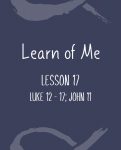Matthew 16–17; Mark 8–9; Luke 9
Thou Art the Christ
A testimony of Christ comes by revelation (Matthew 16: 13 – 17; Luke 9: 18 – 21):
Learning the cultural and historical context of the New Testament can deepen our understanding of the events that happened. For example, today the idea of receiving direct answers from God is not that uncommon. But personal revelation was not a guiding principle for the Jews at the time of Christ.
For them, revelation’s importance only extended to the fact that the commandments came to Moses by revelation on Mt. Sinai. Prayer was important to them, and they believed that a spiritual connection with God could be developed through the keeping of the commandments. But there was no sense of “gaining a testimony” of God or being personally guided through life by revelation.
Additionally, Judaism had become less spiritually-oriented during the reign of King Josiah. The temple at the time had become somewhat of a storage unit. It was in disrepair and King Josiah ordered his priests to arrange for it to be cleaned and fixed up. In the process, scriptures were found. When Josiah read them, he was surprised and realized he had not been living the commandments. He repented and caused his subjects to repent. Scholars now believe that a “Deuteronomic reform” took place under those priests who stripped out some of the most spiritual aspects of the gospel.
So the Jews at the time of Christ were more commandment-oriented than ever before. Yet Christ’s whole ministry depended upon Jews receiving personal revelation and seeing how their traditions testified of the Savior. They needed to be enlightened by the Spirit, which was not part of their system of belief.
Christ’s original disciples had to gain this testimony in an environment very hostile and dangerous for them, but they still did it.
What happened on the Mount of Transfiguration? (Matthew 17:1–9; Mark 9:2–10; Luke 9:28–36):
The experience on the Mount of Transfiguration (most likely Mt. Tabor) seems to have occurred at the time of Sukkoth, the Feast of Tabernacles, in the fall. At the Feast of Tabernacles, Jews build booths reminiscent of those they lived in during the Exodus. These fall holidays evoke imagery of final judgment and Christ’s Second Coming. Peter wanted to make three tabernacles – one for Christ, one for Moses, and one for Elijah.
During this experience, Peter, James, and John saw a vision of the final transfiguration of the earth.
The keys of the Kingdom of Heaven (Matthew 16:13–19; 17:1–9):
This sculpture of Peter by Bertel Thorvaldsen shows Peter holding a pair of large keys. The symbol of God’s power as “keys” helps us understand its importance in “unlocking” the way back to God’s presence. God’s house is a house of order established to bring knowledge, healing, and peace. The keys of the Kingdom are not meant to be wielded as weapons but to grace the earth with the saving power of Christ.




